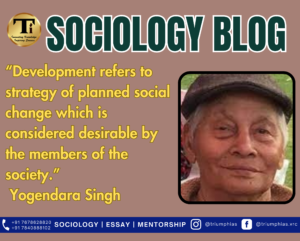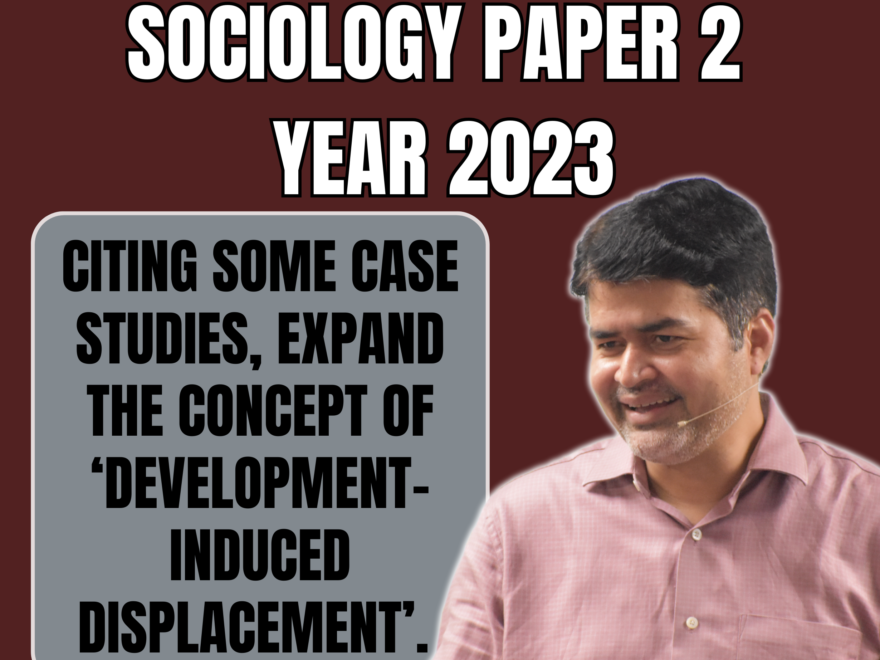Citing some case studies expand the concept of Development-induced Displacement.
Section: B.
Sociology Paper 2023 Analysis.
Relevant for Paper 2: Unit-13 Challenges of Social Transformation : Crisis of Development ; Displacement

Question 5 (a): Citing some case studies expand the concept of Development-induced Displacement.
(10 Marks)
|
Introduction: Explain Briefly the Idea of Development and Displacement. Main Body: Explain Various Dimensions Associated with Development Induced Displacement, Consequences of the Development induced Displacement. Conclusion: Significance of Understanding the Diverse Phenomenon. |
Introduction:
- Earlier development was associated with economic aspects only. It was mostly equated with growth and analysed in terms of increase in per capita income. However further it was realised that the purely economic concept did not capture the social reality. Hence the development is now understood in terms of improvement in living conditions, life chances and quality of life. And displacement is multidimensional phenomenon of which physical relocation is important dimension.
- According to Bartolome displacement is commonly experienced through the loss of land and the disruption of social and economic relationship.
Main body:
Conceptual Aspects Associated With Development Induced Displacement:
- When the government plans some types of development, such as construction of dams, power generation plants, construction of roads or railways and development of industrial areas etc., it acquires land for the purpose. After paying some compensation asks the original owners of the land acquired to vacate it. If they do not do so willingly they are removed from the acquired land by force. This process is termed as development induced displacement.
- According to Ramesh “If development is one side of the coin, displacement is the other side.”
- Development-induced displacement has been a significant phenomenon in the Indian context, where rapid economic growth and infrastructure projects often lead to the uprooting of communities and individuals from their ancestral lands.
- While development projects promise progress and modernization, they can also result in the displacement of vulnerable populations, triggering complex social, economic, and environmental consequences.
- Development-induced displacement often disproportionately affects marginalized and vulnerable communities. Displacement can disrupt the social fabric of these communities, pushing them into migratory patterns as they seek alternative livelihoods
- Consequences of displacement: The consequences of displacement can be categorized into two main groups: Positive and Negative.
-
- Positive impacts of displacement typically benefit only a small portion of the affected community. These include:
-
-
- Some individuals may see improvements in their status through increased landholdings. In certain cases, there may be a rise in income due to employment opportunities created by the Project.
- The development induced displacement enhances the rate of migration of people towards urban areas. It causes enhanced urbanisation and leads to multicultural metropolitans as a meeting point of little and great tradition.The chath puja in DELHI is now well known festival.
- Displacement might lead to a break in oppressive social hierarchies in certain situations.
- Rao’s findings indicate that after displacement, many women are compelled to join the labor market to earn a livelihood and contribute to their family’s income
-
2. Negative Impacts: On the other hand, negative impacts of displacement are felt by the majority of displaced individuals, resulting in a process of dispossession and disempowerment.
-
-
- The development process has the potential to disrupt and dismantle villages, socio-economic structures, and cultural practices. When people are forcibly uprooted from their homes, the following adverse situations often occur:
- Disruption of production systems.
- Loss of productive assets and income sources.
- Relocation to environments where their skills may be less relevant and competition for resources is greater.
- Disorganization of long-established residential groups.
- Scattering of kinship groups.
- Breakdown of informal social networks and safety nets.
- The development process has the potential to disrupt and dismantle villages, socio-economic structures, and cultural practices. When people are forcibly uprooted from their homes, the following adverse situations often occur:
-
-
-
- Michael Cernea’s model is widely discussed in anthropological, sociological, and geographical studies on forced displacement. He identifies eight interconnected trends that together constitute a model of overall impoverishment resulting from displacement. The listed risks include:
- Landlessness
- Joblessness
- Homelessness
- Loss of common property
- Marginalization
- Food insecurity
- Mortality
- Social disarticulation
- Michael Cernea’s model is widely discussed in anthropological, sociological, and geographical studies on forced displacement. He identifies eight interconnected trends that together constitute a model of overall impoverishment resulting from displacement. The listed risks include:
-
-
-
- The consequences of displacement are not uniformly spread across communities and districts. They vary in specific social, economic and cultural contexts. This happens because rural or urban communities are not homogeneous by nature, but are alliances of many social groups with unequal power and resources.
- Walter Fernandes and S. Anthony Raj’s report highlights the diverse nature of affected communities. For instance, those displaced by the Salandi Dam in Keonjhar District can be categorized into various groups, including Tribals and others, landowners, , patta owners, and landless individuals. This heterogeneity is further compounded by distinctions between displaced people (DP) and project-affected persons (PAPs).
- The location of development projects in remote villages, hills, and forests often results in the displacement of indigenous people who has historically acted as the custodians of conservation. As a consequence, displacement leads to the loss of their means of livelihood, habitat, and assets. It also causes social disruption, disorder, and severs their connection from the ecosystem that has traditionally sustained them. Tribal communities have disproportionately borne the brunt of such displacement.
- For example, Fernandes, in his study of Maharashtra, found that in cases of displacement due to projects, the majority affected were tribal communities, with only 15.8% of tribal families being provided with land.
- Furthermore, Utsa Patnaik’s study of the Rengali Rehabilitation colony sheds light on the challenges faced by tribals. It highlights how contractors exploited tribal girls, which had a detrimental effect on their cultural socialization.
-
-
-
- In this situation of land acquisition people are forced to change their profession. They became wage labour, caretaker for the housing project and depend mostly on informal relationships. Sengupta highlighted that Many marginal farmers lost their land and livelihood due to this large-scale urban project .
- Displacement also force migration towards urban areas and breeds another problem such as Child labour and bondage bondage labour.
- Impact on women: The forced resettlement disproportionately affects women, leading to several adverse consequences. Women bear the brunt of losing access to traditional livelihood sources like land, forests, rivers, and pastures, placing additional burdens on them. This loss impacts their health, nutrition, and their ability to secure their children’s future.
- Asthana’s Gender Analysis of Tehri Dam study reveals that displacement often triggers family conflicts over personal expenses because many women become dependent on their husbands’ income.
-
-
-
-
- Koushal’s research shows that forced displacement increases the incidence of domestic violence, reduces women’s participation in productive economic activities, diminishes their social status, and weakens their decision-making authority.
-
-
Conclusion:
Development-induced displacement is a multifaceted issue with wide. It is crucial to recognize the diverse nature of affected communities and the specific context in which displacement occurs, with a particular focus on the challenges faced by women in these situations. Addressing these complex issues is essential for creating more equitable and sustainable development policies.
Related Blogs…
 |
 |

To master these intricacies and fare well in the Sociology Optional Syllabus, aspiring sociologists might benefit from guidance by the Best Sociology Optional Teacher and participation in the Best Sociology Optional Coaching. These avenues provide comprehensive assistance, ensuring a solid understanding of sociology’s diverse methodologies and techniques.
META TAGS: A Contextualize Louis Dumonts concept of binary opposition, A Contextualize Louis Dumonts concept of binary opposition, A Contextualize Louis Dumonts concept of binary opposition, A Contextualize Louis Dumonts concept of binary opposition, A Contextualize Louis Dumonts concept of binary opposition, A Contextualize Louis Dumonts concept of binary opposition, A Contextualize Louis Dumonts concept of binary opposition, A Contextualize Louis Dumonts concept of binary opposition
Why Vikash Ranjan’s Classes for Sociology?
Proper guidance and assistance are required to learn the skill of interlinking current happenings with the conventional topics. VIKASH RANJAN SIR at TRIUMPH IAS guides students according to the Recent Trends of UPSC, making him the Best Sociology Teacher for Sociology Optional UPSC.
At Triumph IAS, the Best Sociology Optional Coaching platform, we not only provide the best study material and applied classes for Sociology for IAS but also conduct regular assignments and class tests to assess candidates’ writing skills and understanding of the subject.
Choose The Best Sociology Optional Teacher for IAS Preparation?
At the beginning of the journey for Civil Services Examination preparation, many students face a pivotal decision – selecting their optional subject. Questions such as “which optional subject is the best?” and “which optional subject is the most scoring?” frequently come to mind. Choosing the right optional subject, like choosing the best sociology optional teacher, is a subjective yet vital step that requires a thoughtful decision based on facts. A misstep in this crucial decision can indeed prove disastrous.
Ever since the exam pattern was revamped in 2013, the UPSC has eliminated the need for a second optional subject. Now, candidates have to choose only one optional subject for the UPSC Mains, which has two papers of 250 marks each. One of the compelling choices for many has been the sociology optional. However, it’s strongly advised to decide on your optional subject for mains well ahead of time to get sufficient time to complete the syllabus. After all, most students score similarly in General Studies Papers; it’s the score in the optional subject & essay that contributes significantly to the final selection.
“A sound strategy does not rely solely on the popular
Opinion of toppers or famous YouTubers cum teachers.”
It requires understanding one’s ability, interest, and the relevance of the subject, not just for the exam but also for life in general. Hence, when selecting the best sociology teacher, one must consider the usefulness of sociology optional coaching in General Studies, Essay, and Personality Test.
The choice of the optional subject should be based on objective criteria, such as the nature, scope, and size of the syllabus, uniformity and stability in the question pattern, relevance of the syllabic content in daily life in society, and the availability of study material and guidance. For example, choosing the best sociology optional coaching can ensure access to top-quality study materials and experienced teachers. Always remember, the approach of the UPSC optional subject differs from your academic studies of subjects. Therefore, before settling for sociology optional, you need to analyze the syllabus, previous years’ pattern, subject requirements (be it ideal, visionary, numerical, conceptual theoretical), and your comfort level with the subject.
This decision marks a critical point in your UPSC – CSE journey, potentially determining your success in a career in IAS/Civil Services. Therefore, it’s crucial to choose wisely, whether it’s the optional subject or the best sociology optional teacher. Always base your decision on accurate facts, and never let your emotional biases guide your choices. After all, the search for the best sociology optional coaching is about finding the perfect fit for your unique academic needs and aspirations.
Follow us :
🔎 https://www.instagram.com/triumphias
🔎 https://www.youtube.com/c/TriumphIAS
🔎 https://t.me/VikashRanjanSociology
Find More Blogs…
| Compare and contrast Karl Marx’s and Max weber’s | Karl Marx- Historical Materialism |
| Position of Women In the Modern Indian Society | Sociology: Social system and pattern variables |
Keywords: Development-induced Displacement, Development-induced Displacement, Development-induced Displacement, Development-induced Displacement, Development-induced Displacement, Development-induced Displacement, Development-induced Displacement, Development-induced Displacement, Development-induced Displacement, Development-induced Displacement, Development-induced Displacement, Development-induced Displacement, Development-induced Displacement



